Last updated: March 27, 2025
Article
Elephant Seal Monitoring Season Summary: Winter 2023-2024
Season Highlights
- Ken Patrick Visitor Center (KPVC) area was a busy elephant seal pupping site this year. The seal count on the beach in front of KPVC was the highest it has ever been - peaking at 139 cows and 96 pups during the first week of February.
- Last year, KPVC count peaked at 72 cows and 62 pups.
- Storms coming from the south, as well as king tides and high surf in early February, led to some pup mortality. Approximately 950 pups weaned this year, compared to the highest count of 1,153 weaned pups in 2021.
- Total seal, cow, pup, and weaned pup counts were lower than the 5-year average.

NPS / Matt Lau - NMFS Permit No. 21425
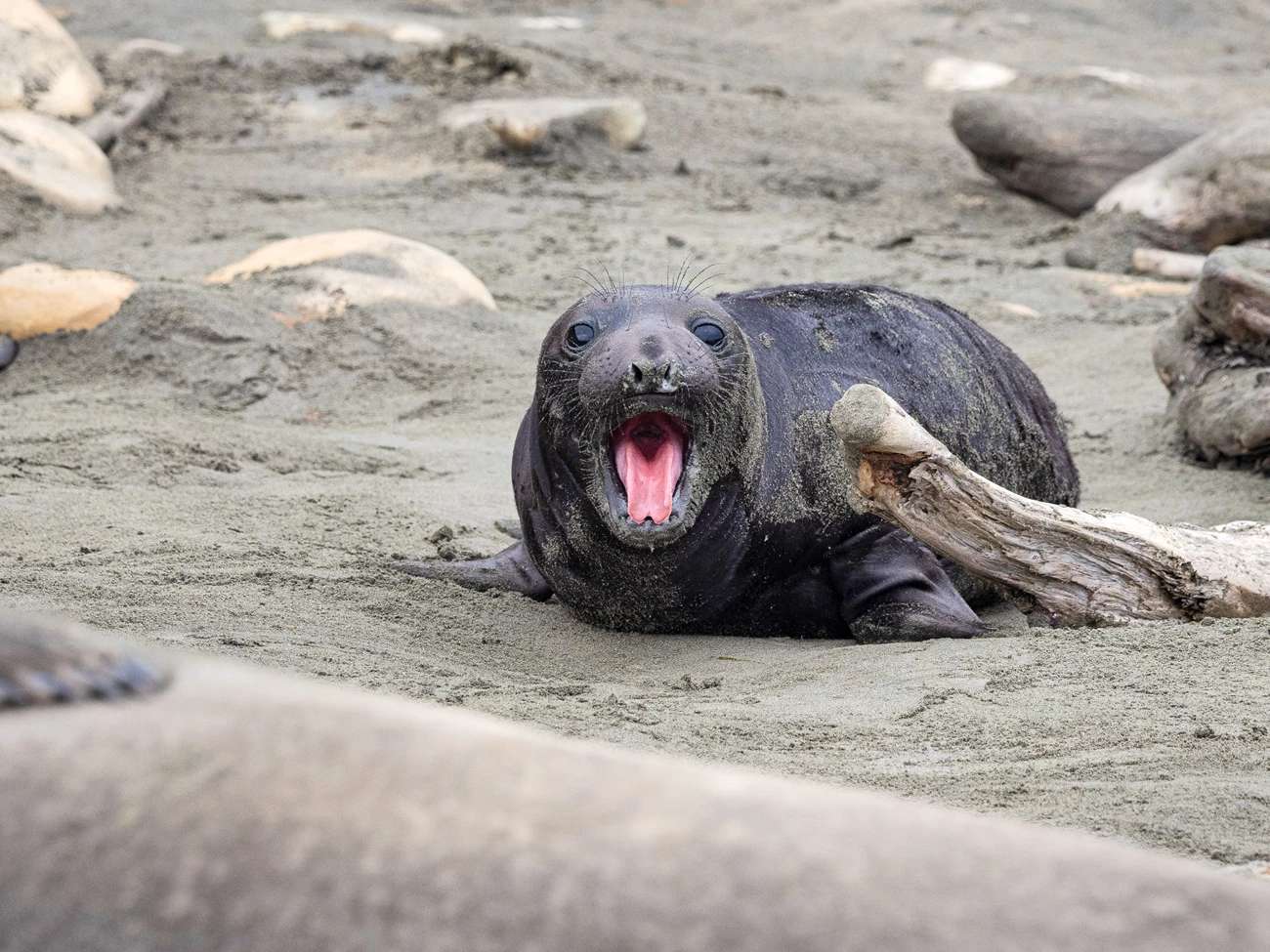
NPS / Matt Lau - NMFS Permit No. 21425
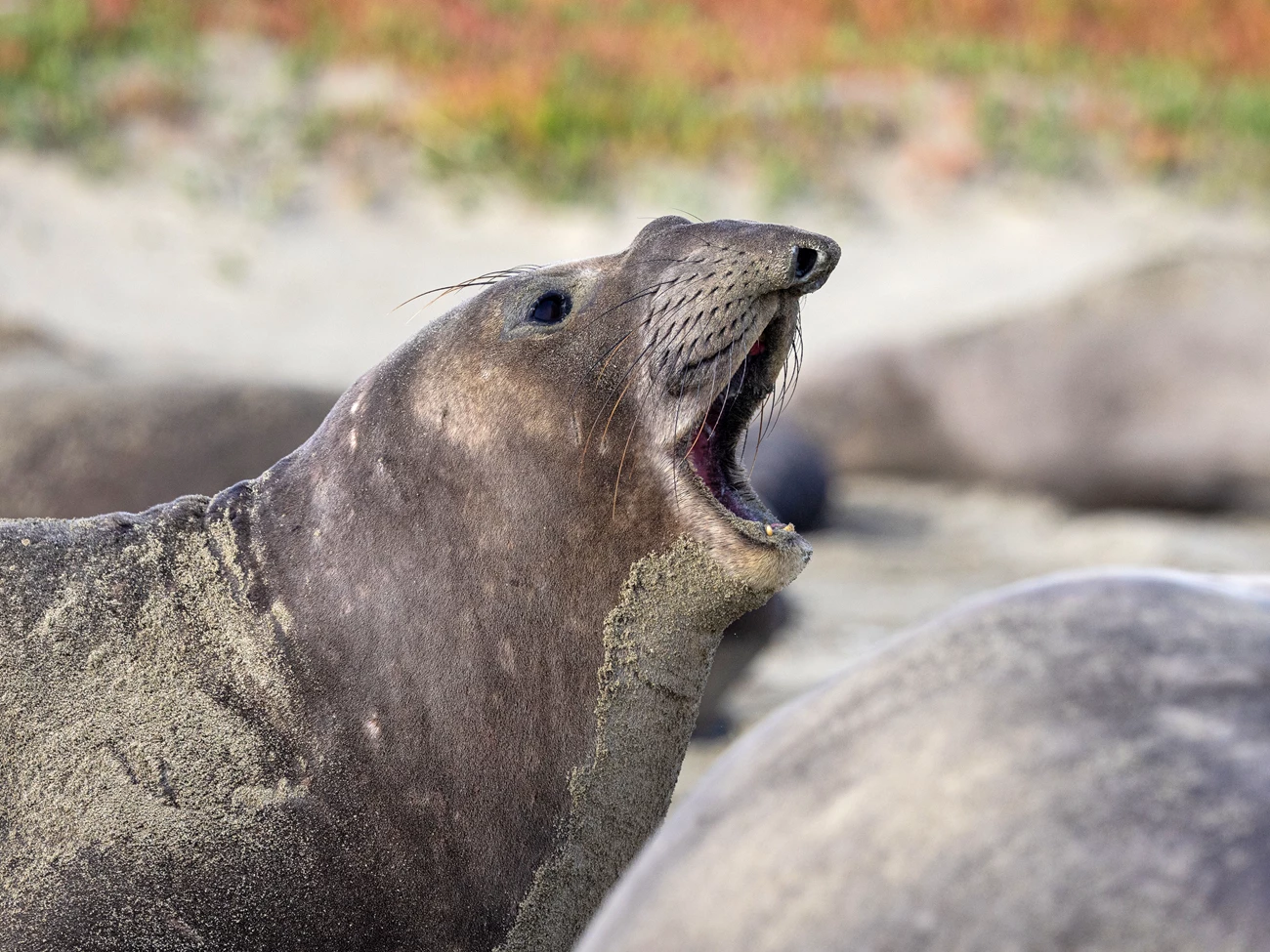
NPS / Matt Lau - NMFS Permit No. 21425
Seasonal Peaks, 2011-2024
Elephant Seal Breeding Season Peaks, 2011-2024
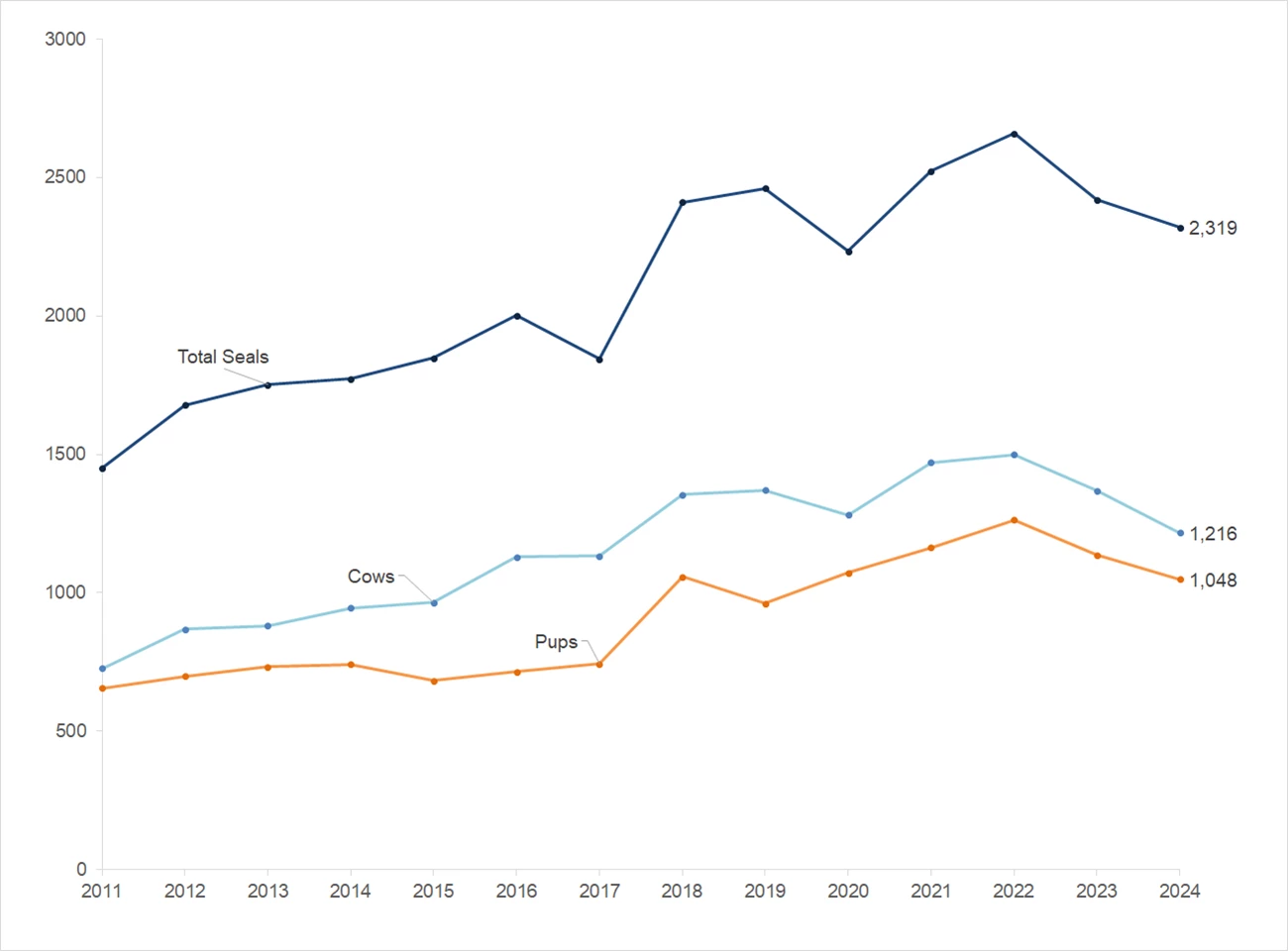
What's next for the seals?
The breeding season for elephant seals is coming to a close. A little over a month ago on January 30, biologists counted 1165 cows; this week biologists counted only 19 cows. That means about 98% of cows have weaned their pup, mated, and returned to the open ocean!
Fret not, as elephant seals are found almost year-round at Point Reyes.
Here is what you can expect in the coming months:
March:
- Males are still on the beach, mating with the last cows. They will head out to sea by the end of the month.
- Weanlings are molting and preparing for their first foraging trip. They will be gone by the end of April.
Late March – June:
- Cows and juvenile seals will return to the beaches to molt.
June – August:
- Males will return to the beaches to molt.
September – November:
- Juveniles, including weanlings from this year, will return to haul out on the beaches.
December:
- Males return to the beaches to begin defending their territories. The arrival of pregnant cows marks the beginning of the new breeding season!
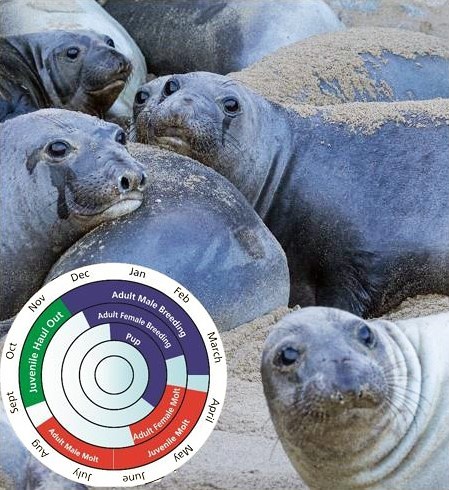
Photo: NPS / Matt Lau - NMFS Permit No. 21425
Catastrophic Molting
Now that the breeding season is almost over, the next time elephant seals will be returning to the beaches at Point Reyes is to undergo catastrophic molting. When elephant seals molt, they grow a new layer of skin and fur. This causes their old fur and skin to come off in large patches, which is why it is termed catastrophic molt.
Elephant seals must return to land to molt because while in the ocean, growing new hair and skin would compromise their insulation from the cold temperatures of the ocean. Once the seals are on land and don’t have to worry about keeping warm, blood is circulated to grow new skin and fur while shedding their old coat. The molting process takes about a month to complete, and the elephant seals are fasting the entire time.
Adult female and juvenile elephant seals return to molt in late March and April while Males return to molt in June and July.
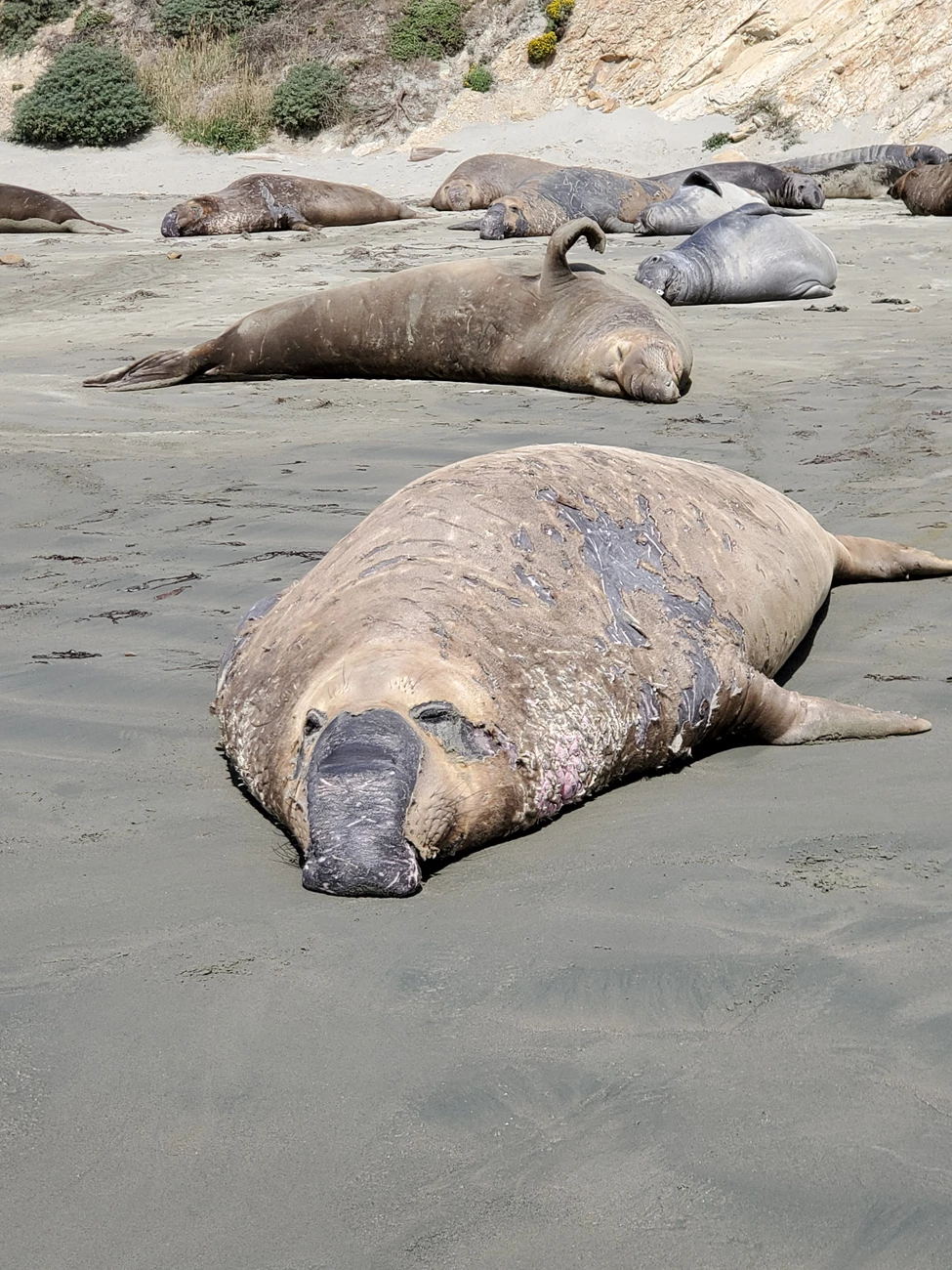
NPS / Sarah Allen - NMFS Permit No. 21425
By the Numbers
Total Elephant Seal Counts, Winter 2023-2024

Female Elephant Seal Counts, Winter 2023-2024
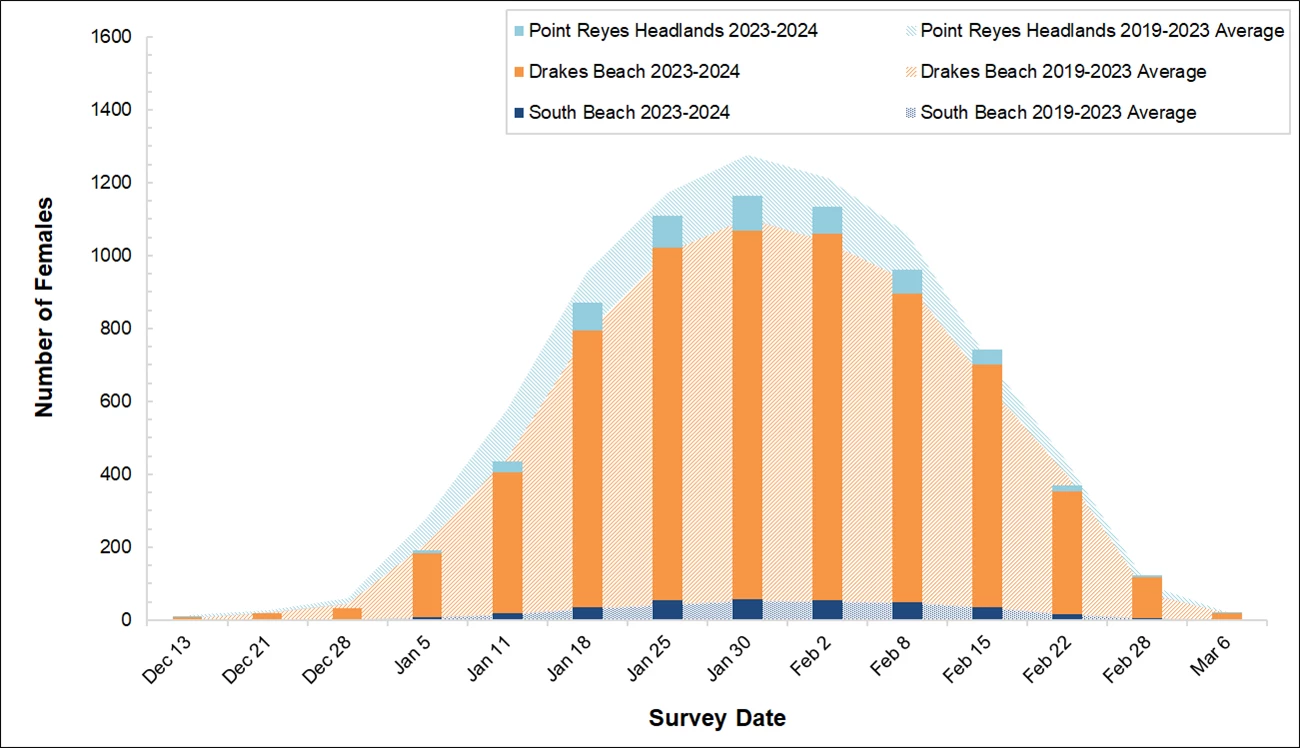
Elephant Seal Pup Counts, Winter 2023-2024

Elephant Seal Weaned Pup Counts, Winter 2023-2024
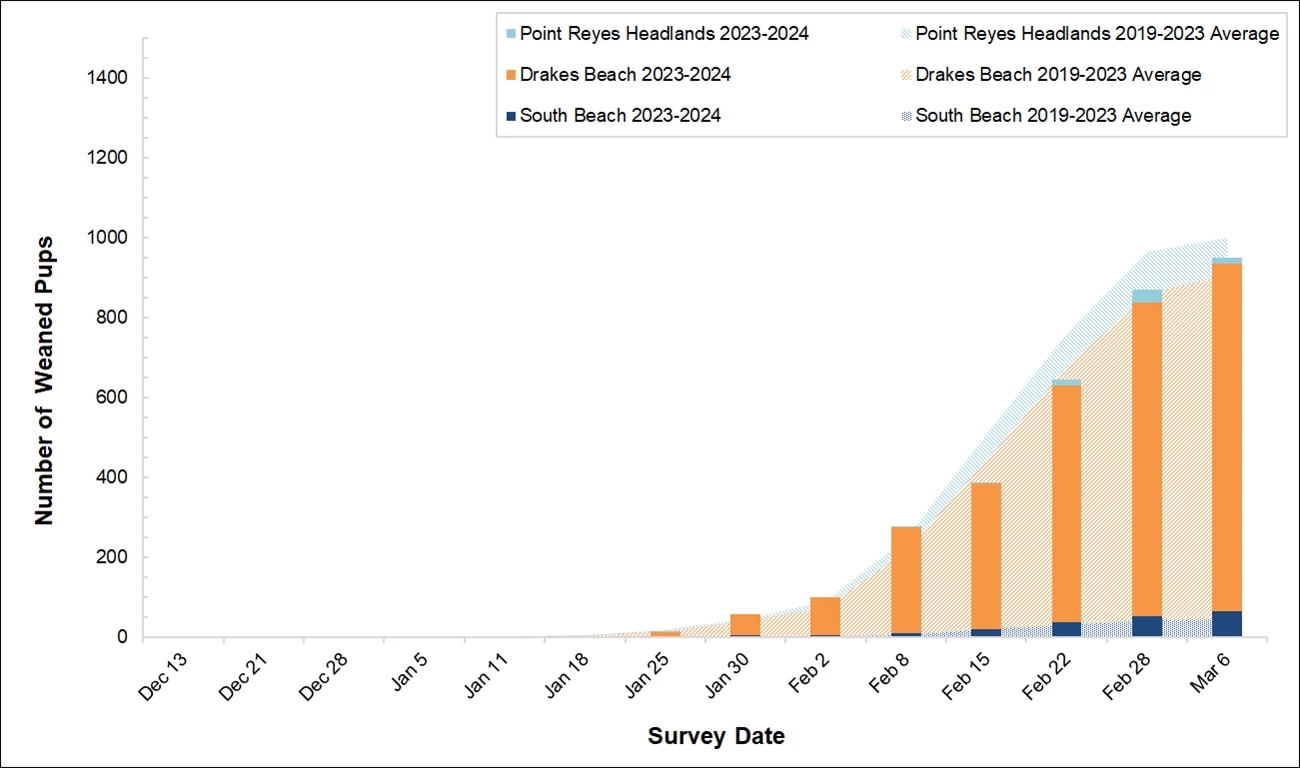
Weekly Updates Recap
News This Week
- The first elephant seal pup of the season was spotted on 12/21. As of 1/5, there are 77 pups!
- Stormy weather and high surf brought many male seals to the beach and ice plant in front of Ken Patrick Visitor Center and the adjacent wetland.
- Biologists have begun dye marking males at Drakes Beach. Look out for seals with a black dye mark on their rear or sides!
- Drakes Beach, the Fish Dock, the beach at the Historic Lifeboat Station, and the southern end of South Beach are closed.
Welcome Back to Land!
They’re back! Elephant seals started arriving at Point Reyes in early December and numbers will continue to increase into late January.
The seals you are seeing have spent most of the year foraging in the open ocean, often over 1,000 miles from land. Although they form loose groups on land, elephant seals are primarily on their own out at sea. Researchers at UC Santa Cruz found that females and males utilize different foraging strategies. Females were found to forage in the deep waters of the open ocean, where there are less predators. However, the fish that they feed on have less nutritional value, so they must constantly forage to keep their energy levels up. Males were found to forage in shallower waters along the continental shelf, targeting highly nutritious benthic prey. But these shallow waters are also home to a higher density of predators—orcas and sharks.
While females prioritize their safety to maximize their reproductive success, males prioritize higher caloric intake to attain larger body sizes necessary to compete for females.
News This Week
- This week’s king tides brought high tides up to seven feet. With no storms or high surf, the elephant seals and pups fared well.
- Total elephant seal numbers in the park are below average. The bulk of the elephant seals are farther down on Drakes Beach.
- The beach and ice plant in front of Ken Patrick Visitor Center continues to be a popular hang out spot for male elephant seals.
- Drakes Beach, the Fish Dock, the beach at the Historic Lifeboat Station, and the southern end of South Beach are closed.
Don't Flip Out!
It is common to see elephant seals of all ages using their front flippers to propel sand onto themselves.
There are multiple reasons for this behavior. Sand flipping is primarily a way of thermoregulation for elephant seals. Elephant seals have thick blubber to keep them warm in cold water. But on a hot day at the beach, they can easily overheat. The wet sand helps reduce the seal’s body temperature. The sand also acts as sunscreen. Seals can also be seen flipping sand when they are agitated.
Timing is Everything!
Female elephant seals continue to arrive at the sandy beaches in Point Reyes to prepare for their pup to be born, and they are right on schedule!
Cows must time their arrival at the beaches perfectly—too early and they can miss out on more foraging opportunities. If they leave too late, they can lose their pup out at sea. Pupping is also timed so that beach temperatures aren’t too hot and weaned pups can forage during spring upwelling, when prey is more abundant.
Using satellite tags on cows, researchers at UC Santa Cruz found that on average, cows arrive at the beach 5.5 days before giving birth. These cows are coming from their foraging grounds, thousands of miles out at sea. They will travel 40-50 miles per day to time their arrival perfectly for when their pup needs to be born. Cows running late will swim faster to cover more distance and shorten the delay between arrival and giving birth. One latecomer in the study gave birth within 30 hours of arriving at the beach!
News This Week
- As of 1/18, five elephant seal pups have been born in front of Ken Patrick Visitor Center! Cows continue to arrive, with 13 cows counted on 1/18.
- The Drakes Beach parking lot is open 10 am – 4 pm.
- Remember to keep voices down around the viewing area as to not disturb the seals and pups.
- Total elephant seal counts remain below the 5-year average.
Entanglement in Marine Mammals
Marine mammals, including elephant seals, are often found entangled in ocean trash, particularly fishing gear and plastics. Entangled animals can drown, starve, and develop physical traumas or infections, which often leads to death. Although some individuals survive, hundreds of thousands of marine mammals die each year from entanglement.
It is important to pack out all fishing gear and trash.
Where Art Thou?
In dense elephant seal colonies, where there can be hundreds of cows and pups, it is essential for a mother to be able to recognize her own pup. Within 1-2 days of giving birth, cows bond with their pup through their scent and vocalizations. Even then, environmental factors and individuals moving around the harem risks pup separation. Orphaned or lost pups will often die; pup survivorship hinges on successful maternal care. Researchers at UC Santa Cruz studied the responsiveness of cows to the vocalizations of their pup to see if it affected weaned pup size. They found variability in responses, with some cows being highly reactive and others more passive to their pup’s calls. However, they also found that cows with consistent responses, whether reactive or passive, weaned heavier pups.
News This Week
- The storms over the weekend brought in a huge number of elephant seal cows to Ken Patrick Visitor Center. There are a total of 75 cows and 47 pups as of 1/25.
- Biologists spotted the first weaned pup of the season at the Elephant Seal Overlook on 1/22! There are 14 weanlings across all sites as of 1/25.
- A flipper tagged cow (K659) at Elephant Seal Overlook was found to be 18 years old! She was seen nursing her young pup.
- Total elephant seals in the park remain below the 5-year average.
No Food, No Problem
Once a pregnant cow arrives on the beach, she will not feed or drink again for around a month. Cows must focus on their most important task of giving birth and then nursing their newborn, 60 lb. pup. Weight gain is essential for pups– they must reach at least 300 lbs., a fivefold increase in body weight, to survive after weaning. To expedite this weight gain, cows produce energy dense milk, which at peak levels during the lactation period, contains 10% protein, 55% fat, and 35% water. In comparison, human breast milk is 5% fat, <1% protein, and 85% water! Cows produce around 300 lb. of milk and average 4 liters of milk a day to their pup. As their pup balloons in size, cows rapidly lose up to 40% of their body mass. Once the pup is weaned off their mother, they too must fast for about 2 months as they learn to swim, dive, and forage on their own. Male elephant seals also fast when they arrive on the beach to maintain their dominance and mating advantage in a harem.
Tag Along With the Seals!
As pups begin to wean from their mother, biologists here at Point Reyes, and biologists at other elephant seal rookeries along the coast, will start flipper tagging weanlings. Tags are applied into the interdigital webbing of the rear flippers. Each tag has a unique alphanumeric code and a color specific to each site. These flipper tags allow biologists at different sites to keep track of the elephant seals movement and gain more insight on pup mortality, life expectancy, site fidelity, and reproductive success.
Pink – Point Reyes and Farallon Islands
Green – Año Nuevo
White – San Simeon/ Piedras Blancas
Blue – King Range in the Lost Coast area
If you see a flipper tag, write down its color and number, or take a picture, and share it with park staff.
News This Week
- The storm on Wednesday brought even more elephant seal cows to Ken Patrick Visitor Center! As of 2/2, there are 108 cows and 87 pups.
- The storm on Wednesday coupled with the high surf led to some pup mortality. The Point Reyes Headlands was hit the hardest.
- Pups continue to be weaned! There are a total of 99 weanlings in the park as of 2/2/24.
- The total elephant seal count in the park continues to be below the 5-year average.
No Pressure
When observing an elephant seal rookery, many seals will look like they have runny noses! This white substance is pulmonary surfactant–essential for breathing in all mammals, including humans. The main function of this surfactant is to decrease the surface tension of lung fluid, thus allowing for gas exchange between the lungs and blood. In elephant seals, this surfactant also acts as an anti-adhesive. Elephant seals experience extreme pressure differentials when diving to depths of up to 3000 feet. This means their lungs are collapsing on the dive down and re-inflating on their return to the surface. Pulmonary surfactant prevents lung tissues from sticking to each other during these dives. So, a seal with lots of surfactant is a healthy seal!
It's Mating Time!
During the last week of nursing, cows will come into estrus and begin mating with males. Elephant seal females have evolved a reproductive strategy called delayed implantation, where implantation of the fertilized egg in the wall of the uterus is delayed – for elephant seals this delay is around four months. This strategy is beneficial for multiple reasons. First, it enables the cows to gain some weight back after their significant weight loss during the breeding season. Another reason is for synchronization. While most cows mate around February and March, 15-20% of births are from new mothers or juvenile females who are not on the beach during the breeding season; they breed at varying times. But all cows will return to land to molt in April and May and implantation will occur when they are departing the beach. This means that although there can be variation in breeding timing, the gestation period begins at around the same time for all cows. All cows will be right on schedule to give birth in seven to eight months!
News This Week
- Sunday’s atmospheric river moved many elephant seals around the park. Ken Patrick Visitor Center now has 138 cows, 96 pups, and 6 weaned pups!
- The atmospheric river caused more pup mortality. However, most of the pups survived the storms.
- There are a total of 278 weanlings in the park as of 2/8/24.
- The total elephant seal count in the park continues to be below the 5-year average.
Fight or Flight
The goal of the male elephant seal during the breeding season is to mate with as many females as they can. To do this, they compete for dominance over harems of cows. They have several competitive responses: vocalizations, physical posturing (where males rear up their chest), seismic signaling (where males slap their chests onto the sand), and physical fighting. Only about 5% of interactions lead to physical confrontations. Using playback experiments and acoustic analysis, researchers at UC Santa Cruz found that elephant seal males learn and recognize each other’s distinctive vocalization. Furthermore, they found that alpha males respond to all aggressors while subordinate males respond based on previous outcomes of competitive interactions. This is for good reason—male elephant seals are fasting while on land and must balance their time between conserving energy and competing. By recognizing their competitors, they can save their energy and avoid unnecessary fights. This recognition is also important for maintaining the social hierarchy.
News This Week
- Mating is ramping up! Male elephant seals have been vocalizing, chasing, and fighting each other in front of Ken Patrick Visitor Center.
- Biologists are tagging weaned pups, including the ones at Ken Patrick Visitor Center. Keep an eye out for the pink flipper tags, starting with an ‘X’!
- There are a total of 388 weanlings in the park as of 2/15/24.
- The total elephant seal count in the park continues to be below the 5-year average.
Weanling Facts
- Cows nurse their pups for about 28 days and then depart. It is up to the weanlings to learn how to swim, forage, hold their breath, and navigate on their upcoming foraging trip.
- On their first trip at sea, weanlings will dive long, deep, and continuously, spending most of the time submerged in the ocean.
Using tracking technology on weanlings, a study at UC Santa Cruz found that:
- Within a few days of departure to the ocean, weanlings reached depths of 300 ft in their dives. Within 30 days, they reached around 850 ft.
- On the first day at sea, weanlings can dive for up to 11 minutes. By the end of their trip, it’s around 20 mins – similar to an adult female.
Upon return from their first trip at sea:
- Weanlings return at around the same mass as their departure but with significant fat loss of up to 41%.
News This Week
- Weanlings are finding their way into different areas around Ken Patrick Visitor Center. Notify staff of any weanlings outside the beach.
- There are a total of 645 weanlings in the park and 61 weanlings at KPVC as of 2/22/24
- This year, biologists are seeing more elephant seals and pups by Horseshoe Pond, northeast of KPVC.
- Total elephant seal, cow, pup, and weanling counts remain below the 5-year average.
May the best mate win!
The dominance hierarchy and territories of male elephant seals are established on the beaches even before females arrive on the beach in December. Throughout the breeding season, males defend their growing harems from competing males. This is so that during estrus, the dominant male can mate with as many cows in his harem as possible. Although dominant males make up most of the breeding, subordinate males employ some strategies to try their luck and mate with cows.
Sneaker male strategy – a strategy used by young, subordinate males – is to lurk on the edge of the harem and sneak in to mate with cows while the dominant male is not paying attention. Unfortunately for the sneaker males, this strategy is not usually successful as the cows are not receptive and often vocalize, alerting the alpha, who swiftly scares off the subordinates.
Skulker male strategy – a strategy where a subadult male encroaches the harem to mate at night, under the cover of darkness. They’ll leave and skulk to different harems.
El Niño and Elephant seals
The El Niño-Southern Oscillation (ENSO) cycle is a periodic climate pattern that occurs in the eastern tropical Pacific Ocean. El Niño events are not predictable but occur irregularly at intervals of about 2 to 7 years. During El Niño, warm water is pushed toward the west coast of the Americas, causing wetter conditions on the Gulf coast. This warm water also weakens or stops the upwelling of cold, nutrient rich water that phytoplankton rely on for photosynthesis. Decreased phytoplankton and warmer water can alter the environmental landscape and trophic chains of marine ecosystems, which affects marine predators like elephant seals. Researchers at Sonoma State and UC Santa Cruz compared foraging behavior of cows during the 1997-98 El Niño, one of the strongest of the 20th century, to other years, using time-depth recorders and satellite tracks. They found that cows spent less time in prey patches and more time traveling between prey patches. They also found that mass gain was the lowest measured since 1983. Females also returned with lower average fat stores than in other years. Natality during the 1999 breeding season was 87%, the lowest ever recorded at the colony, compared to the average of 96.5%.
More information is available in the original study, "Impact of El Niño on the foraging behavior of northern elephant seals."
Elephant Seal Seasonal Monitoring Updates Home >>
Elephant Seal Colonies and Beach Closures Map >>
The National Park Service shall not be held liable for improper or incorrect use of the data described and/or contained herein. These data and related graphics are not legal documents and are not intended to be used as such. The information contained in these data is dynamic and may change over time. The data are not better than the original sources from which they were derived. It is the responsibility of the data user to use the data appropriately and consistent within the limitations of geospatial data in general and these data in particular. The related graphics are intended to aid the data user in acquiring relevant data; it is not appropriate to use the related graphics as data. The National Park Service gives no warranty, expressed or implied, as to the accuracy, reliability, or completeness of these data. It is strongly recommended that these data are directly acquired from an NPS server and not indirectly through other sources which may have changed the data in some way. Although these data have been processed successfully on computer systems at the National Park Service, no warranty expressed or implied is made regarding the utility of the data on other systems for general or scientific purposes, nor shall the act of distribution constitute any such warranty. This disclaimer applies both to individual use of the data and aggregate use with other data. The National Park Service requests that the data user refrain from publishing these data and related graphics and wait until data is available in official, published reports.
